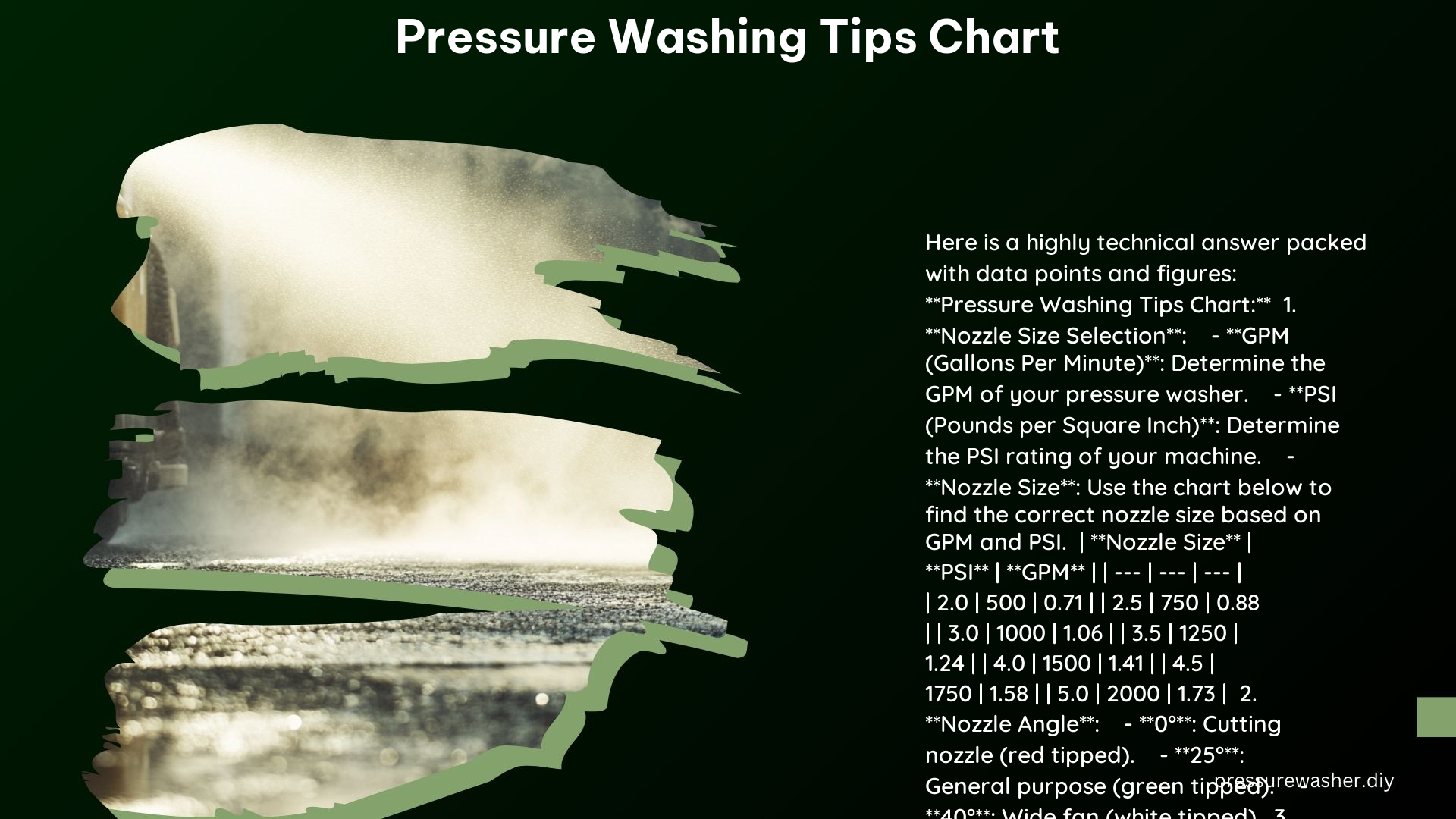Pressure washing is a highly effective way to clean a variety of surfaces, from driveways and patios to siding and decks. However, to achieve the best results and avoid damage, it’s crucial to understand the importance of nozzle selection and pressure control. This comprehensive guide will delve into the intricacies of pressure washing tips charts, providing you with the knowledge and tools to tackle your next pressure washing project with confidence.
Understanding Nozzle Charts
Nozzle Size and Angle
The nozzle size is represented by a numerical value, such as 4.0, which indicates the orifice size of the nozzle. This orifice size directly affects the flow rate and pressure of the water being expelled from the pressure washer. The angle of the spray, represented in degrees (e.g., 25°), determines the fan angle of the spray pattern, which can be adjusted to suit different cleaning tasks.
Determining Correct Orifice Size
To find the correct orifice size for your pressure washer, you’ll need to cross-reference your machine’s GPM (gallons per minute) and PSI (pounds per square inch) ratings with a nozzle size chart. This chart will provide the recommended nozzle size based on your pressure washer’s specifications. It’s essential to consider the maximum PSI rating of your pressure washer and the desired flow rate to select the appropriate nozzle size.
For example, if your pressure washer has a maximum PSI rating of 3,000 and a flow rate of 3 GPM, a nozzle size chart might recommend a 4.0 nozzle. This nozzle would provide the optimal balance of pressure and flow rate for your machine.
Using a Nozzle Chart to Lower Pressure on a Surface Cleaner

Reducing PSI
When using a surface cleaner attachment, it’s often necessary to lower the pressure to prevent damage to the surface being cleaned. To achieve this, you can refer to a nozzle chart and use a larger nozzle size. By increasing the nozzle size, you’ll reduce the pressure while maintaining the desired flow rate.
As a general rule of thumb, you can cut the recommended nozzle size in half for the surface cleaner to achieve the desired pressure reduction. For example, if the nozzle chart recommends a 4.0 nozzle for your pressure washer, you would use a 2.0 nozzle on the surface cleaner to lower the pressure.
Technical Specifications
Nozzle Size Chart
A nozzle size chart is a valuable tool that provides a correlation between nozzle size, PSI, and GPM ratings. This chart helps ensure proper nozzle selection, preventing equipment damage from using a nozzle that is too small and ensuring effective cleaning by avoiding nozzles that are too large.
Here’s an example of a nozzle size chart:
| Nozzle Size | PSI | GPM |
|---|---|---|
| 2.0 | 1000 | 1.3 |
| 2.5 | 1500 | 1.5 |
| 3.0 | 2000 | 1.8 |
| 4.0 | 3000 | 2.4 |
| 5.0 | 3500 | 2.8 |
By referencing this chart, you can quickly determine the appropriate nozzle size for your pressure washer’s specifications, ensuring optimal performance and preventing potential damage.
Advanced Tips and Considerations
Pressure and Flow Rate
It’s important to understand the relationship between pressure and flow rate when selecting the correct nozzle size. Higher pressure requires a smaller orifice size to maintain the desired flow rate, while lower pressure requires a larger orifice size to maintain the desired flow rate.
For example, if you need to increase the pressure of your pressure washer, you would use a nozzle with a smaller orifice size. Conversely, if you need to decrease the pressure, you would use a nozzle with a larger orifice size.
Nozzle Calculator
To simplify the process of finding the correct nozzle size, you can utilize online nozzle calculators. These tools allow you to input your pressure washer’s specifications, such as GPM and PSI, and they will provide the recommended nozzle size based on your input.
Using a nozzle calculator can save you time and ensure you select the appropriate nozzle for your pressure washing needs.
References
- Reddit: Replacement Nozzle Size Chart
- Generac: Pressure Washer Nozzle Guide
- Pressure Washing Institute: Nozzle Chart
- PW Outlet: Nozzle Sizing Chart
- Portland Compressor: Pressure Washer Nozzle Selection Guide
By understanding the intricacies of pressure washing tips charts, you’ll be able to select the right nozzle size and maintain the appropriate pressure for your specific pressure washing tasks. This knowledge will help you achieve the best results while protecting your equipment and the surfaces you’re cleaning.
